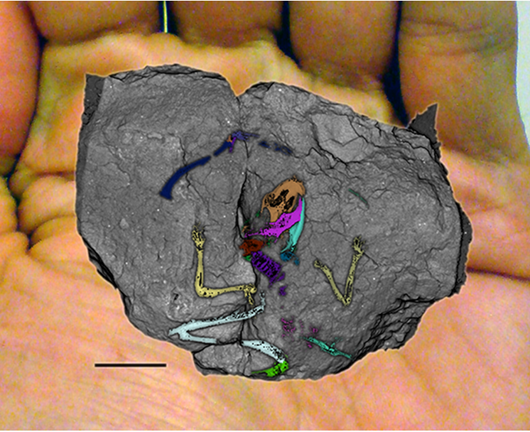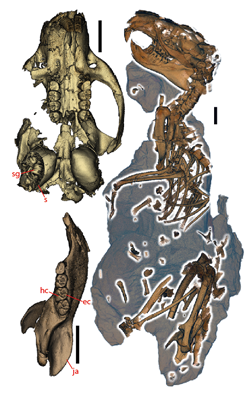Submitted by Rachel Aucott on Mon, 22/07/2019 - 15:01
Researchers in the Department have discovered that the bones and teeth from the oldest, most complete rodent fossils related to pocket mice and squirrels are consistent with DNA from living mammals in supporting one evolutionary Tree of Life.
Two ancient fossils found in Wyoming have been rigorously investigated using a Micro CT scanner combined with DNA from recent species to test if fossil morphology corresponds with the tree of living animals (and it does).
The first image (right) is of a fossil skeleton of Heliscomys ostranderi (USNM PAL 720183) from Jenny’s Pocket, Flagstaff Rim, Wyoming, about is 34 million years in age. The fossil is in situ, inside original block in which it was CT scanned, with a human hand and 10mm bar for scale. This tiny rodent, with a skull slightly over half-an-inch (17mm) long, weighed just a few grams and shows an elongate ankle and hindlimb, indicative of a terrestrial locomotion adapted for speed and jumping. This resembles living kangaroo rats and pocket mice, but is very different from large, burrowing pocket gophers, all of which are closely related rodents, descended from an ancestor shared with this fossil.
Dr Rob Asher and PhD student Aime Rankin, along with colleagues from the University of Durham and the Smithsonian Institution found that living pocket gophers from the Americas, up to 1kg in size and living almost entirely underground, evolved from tiny, pocket-mouse-like rodents that lived over 35 million years ago and weighed just a few grams.
The second image (left) is Ischyromys sp. (USNM PAL 617732) from West Canyon Creek, Wyoming, and is about 40 million years in age. The skeleton was virtually dissected with microCT scanning and is shown in its original matrix (right), skull in ventral view (top left), and left jaw (bottom left). Scalebars are 10mm. Ischyromys and the living mountain beaver (Aplodontia) are both closely related to modern squirrels, marmots, chipmunks, and other sciurid rodents. Ischyromys shows a similar pattern of jaw-closing muscles as modern sciurids, more so than Aplodontia. Squirrels and the American "mountain beaver" (Aplodontia) share and evolutionary history with fossils like Ischyromys, independent from other rodents for about 40 million years.


